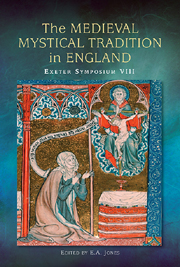 The Medieval Mystical Tradition in England
The Medieval Mystical Tradition in England Book contents
- Frontmatter
- Contents
- Lists of Diagrams and Figures
- List of Contributors
- Abbreviations
- Introduction
- The Colours of Contemplation: Less Light on Julian of Norwich
- Behold Not the Cloud of Experience
- Walter Hilton on the Gift of Interpretation of Scripture
- Numeracy and Number in The Book of Margery Kempe
- Religious Mystical Mothers: Margery Kempe and Caterina Benincasa
- Authority and Exemplarity in Henry Suso and Richard Rolle
- Mortifying the Mind: Asceticism, Mysticism and Oxford, Bodleian Library, MS Douce 114
- The Meditaciones of the Monk of Farne
- Envisioning Reform: A Revelation of Purgatory and Anchoritic Compassioun in the Later Middle Ages
- Walton's Heavenly Boece and the Devout Translation of Transcendence: O Qui Perpetua Pietised
- Reformist Devotional Reading: The Pore Caitif in British Library, MS Harley 2322
- Richard Whytford, The Golden Epistle, and the Mixed Life Audience
- Afterword: Future Prospects
- Index
Authority and Exemplarity in Henry Suso and Richard Rolle
Published online by Cambridge University Press: 05 July 2013
- Frontmatter
- Contents
- Lists of Diagrams and Figures
- List of Contributors
- Abbreviations
- Introduction
- The Colours of Contemplation: Less Light on Julian of Norwich
- Behold Not the Cloud of Experience
- Walter Hilton on the Gift of Interpretation of Scripture
- Numeracy and Number in The Book of Margery Kempe
- Religious Mystical Mothers: Margery Kempe and Caterina Benincasa
- Authority and Exemplarity in Henry Suso and Richard Rolle
- Mortifying the Mind: Asceticism, Mysticism and Oxford, Bodleian Library, MS Douce 114
- The Meditaciones of the Monk of Farne
- Envisioning Reform: A Revelation of Purgatory and Anchoritic Compassioun in the Later Middle Ages
- Walton's Heavenly Boece and the Devout Translation of Transcendence: O Qui Perpetua Pietised
- Reformist Devotional Reading: The Pore Caitif in British Library, MS Harley 2322
- Richard Whytford, The Golden Epistle, and the Mixed Life Audience
- Afterword: Future Prospects
- Index
Summary
The works of two exemplary figures of fourteenth-century spirituality, Henry Suso and Richard Rolle, grant us insight into some of the most significant commonalities between the devotional cultures of fourteenth-century England and Germany. The reception history of the two authors demonstrates their skill in composing narratives and creating characters which subsequent generations of readers found compelling aides to their spiritual development and contemplative practices. The similarities between the two authors, while to a certain extent rooted in some of their common sources, nevertheless testify to the popularity of a particular type of self-fashioning as both author and eponymous character. Both this strategy of authorial self-presentation and the array of thematic commonalities they share can shape our understanding of the role their texts played in the process of transmission and translation of spiritual concepts between England and Germany in the later Middle Ages. Suso and Rolle, besides their many thematic and structural similarities, also had particular success in capturing the attention of readers and translators both religious and lay from the second half of the fourteenth century until the beginning of the seventeenth.
In particular, one of the central points of commonality between Suso and Rolle lies in what I term ‘devotional mobility’. By this I mean not only the instances of physical and spiritual mobility inherent in both (for instance, Rolle's account of wandering between insufficiently solitary hermitages and Suso's persecution while on trips to provincial chapters demonstrate the role of physical mobility in their self-descriptions; both explore the directional framework of spiritual ascent within the space of the visionary event as a type of spiritual mobility).
- Type
- Chapter
- Information
- The Medieval Mystical Tradition in EnglandPapers Read at Charney Manor, July 2011 [Exeter Symposium 8], pp. 93 - 108Publisher: Boydell & BrewerPrint publication year: 2013


